How To Upload Resume From Chromebook
Chromebook Tips
Chromebook crook sheet: How to get started
Got a new Chromebook? This guide will aid y'all navigate the always-expanding world of Chromebook apps and figure out how to make the almost of Chrome OS.
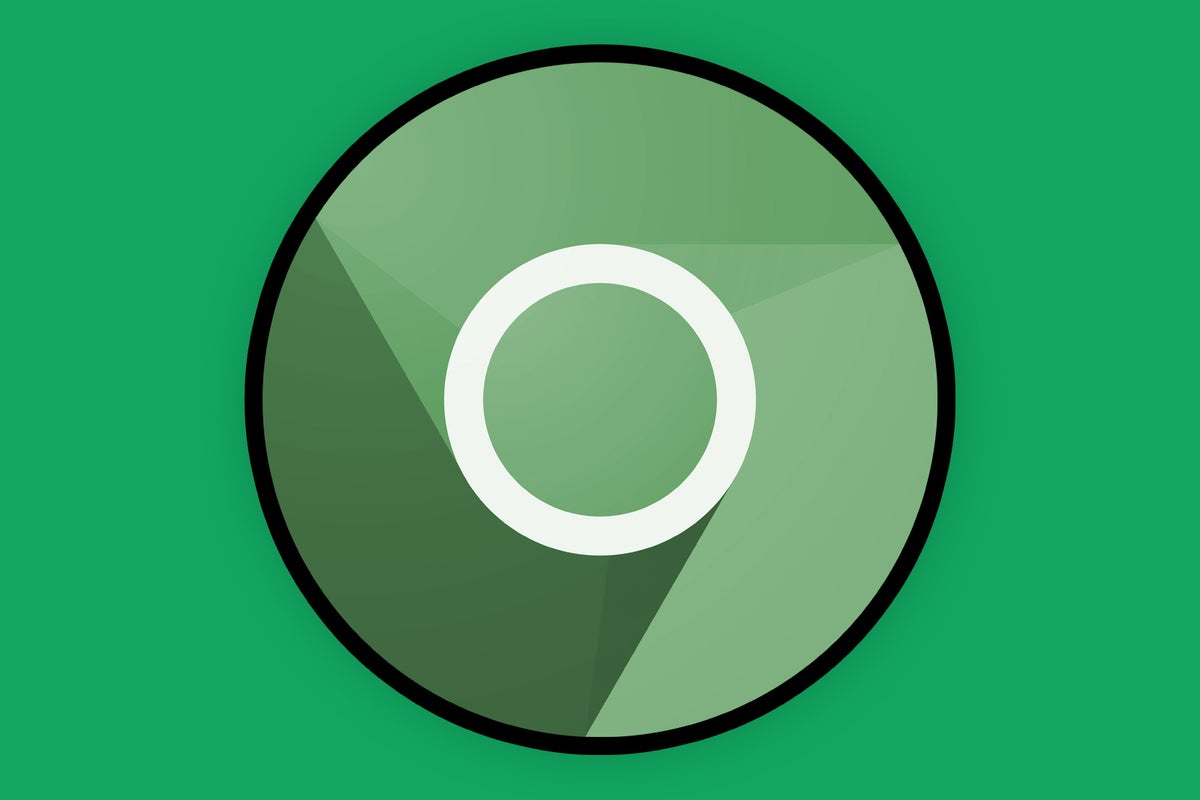
The beauty of Chrome Bone today is its versatility: The operating arrangement supports a huge range of applications in a diverseness of dissimilar formats — web apps, progressive web apps, native Chrome OS programs and Chrome browser extensions, Android apps, Linux apps, and sometimes even Windows apps (gracious!).
That's enough to make anyone's caput spin. As a outcome of that platform-defying setup, though, Chromebooks tin now handle all sorts of advanced productivity tasks and are viable far beyond their original web-axial focus, when the concept was quite literally only a "browser in a box" — a full-screen Chrome window with no desktop, nothing resembling a traditional app, and next to no options to consider.
Merely with power comes complication, and — you guessed it — the weakness of Chrome OS today is that very aforementioned versatility. With then many types of apps and then many sources for software, it's almost impossible to know where to begin and how to get started on your Chromebook adventure. And that's to say cipher of figuring out the finer points of the operating system and how to optimize the environment for efficiency.
The interface itself may yet be relatively minimalist, compared to other operating systems — with its customizable dock (the "shelf") for holding oftentimes-accessed programs, its scrolling app drawer (the "launcher") for finding everything else installed on a system, and its Android-reminiscent settings and notification console — but beyond that unassuming surface, at that place's actually a fair corporeality going on.
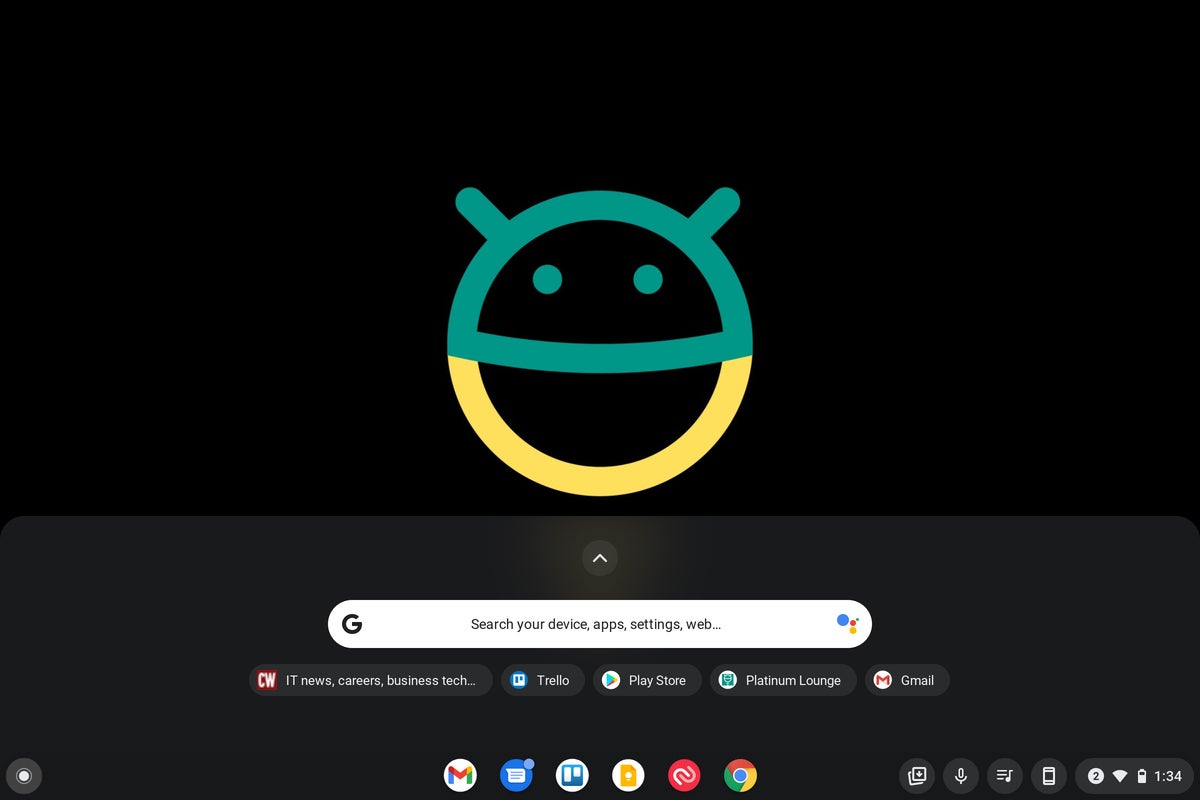 JR Raphael/IDG
JR Raphael/IDG The main Chrome Bone desktop doesn't accept much, only the launcher's search function and the docked icons in the shelf make information technology easy to access everything you need. (Click image to enlarge information technology.)
For a platform in one case touted for its simplicity, things sure take gotten complicated. But they don't have to exist daunting. Follow this advisedly crafted guide to getting started with Chrome Os — both finding the right apps from the correct places and getting your arrangement organized for optimal efficiency — and we'll have you lot up and running with a custom-tuned setup in no time.
Step 1: Figure out what apps you need — and where to notice them
The first step is but to make up one's mind what software you demand on your Chromebook — what apps will near effectively assistance you get your work (and non-work) accomplished. Make a quick list of your essentials: What app or service practice you adopt to use for email? Practise yous need an app for chatting with colleagues? What about projection management? Image editing? Annotation taking? Discussion processing and other part work?
In one case yous've figured out what programs you lot want, it's time to think through the best place to discover each of them. Let'due south go through the main Chrome OS app types 1 by one and see which might brand the most sense for different items on your list:
Spider web apps
In general, with almost Google apps and web-centric services, you'll be fine sticking with the regular web versions — the same sites yous ever pull up in your browser. Yous can even create shortcuts to make them wait and act more like apps and to keep them readily accessible: But open the appropriate site in a normal browser tab, click the three-dot menu icon in Chrome's upper-right corner, and and then select "More tools" followed by "Create shortcut." Give the shortcut whatsoever name yous want — and if you lot'd like it to open in its own app-like window instead of a standard browser tab, select the "Open as window" selection.
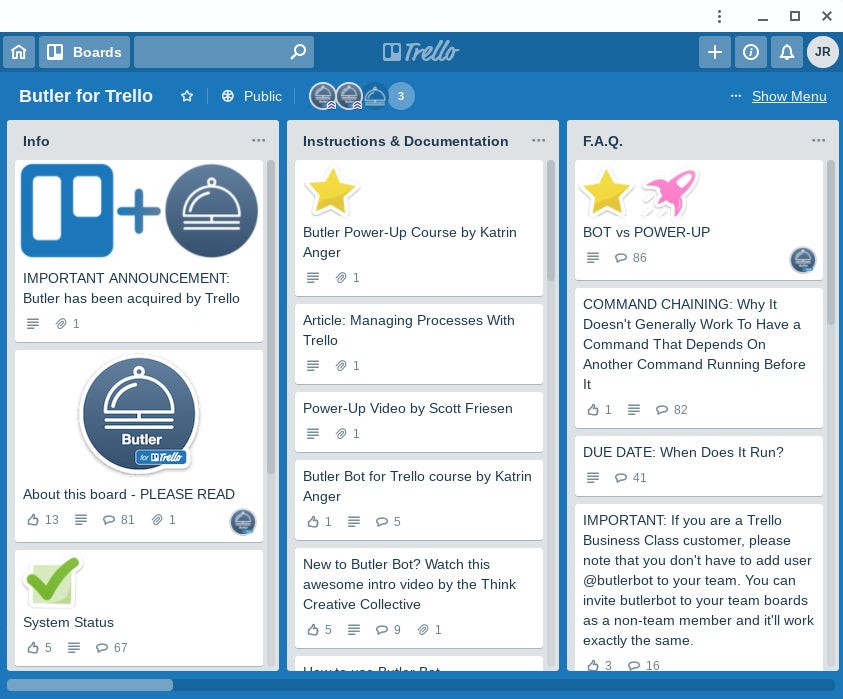 JR Raphael/IDG
JR Raphael/IDG When y'all create a web shortcut and then set the site to open every bit a window, it looks and acts similar an app. (Click image to enlarge it.)
If you lot want to become really avant-garde and customize the app's icon and fifty-fifty the color scheme of its window, follow the steps outlined here.
Progressive web apps
Nosotros've heard a lot of buzz lately about progressive spider web apps, or PWAs — apps that install directly from the browser and so look and human action like regular desktop apps, with their own standalone windows and shortcuts, speedier first times, and built-in support for offline use.
PWAs can be a dainty alternative to regular web apps, simply the problem is that there just aren't a ton of worthwhile options at this signal — nor is in that location whatever spectacular storefront for browsing through bachelor options.
Non to worry, though: I've got you covered. I maintain an evolving list of the best PWAs for productivity. Y'all tin reference that guide for a broader set of worthwhile recommendations, only here are a few quick highlights that are particularly relevant to the Chromebook realm:
- The Todoist PWA looks, feels, and acts almost exactly like a regular local programme, and it lets you lot work with your lists and notes even when y'all're offline.
- The Zoom PWA frees you from the scaled-back website version of the videoconferencing service and lets you lot make and identify calls with a fuller set of features and an feel that'due south optimized for the Chrome Bone environment.
- And Photopea tin act equally an admirable Photoshop-level graphics editing suite for your Chromebook, with or without an agile internet connection.
 JR Raphael/IDG
JR Raphael/IDG No matter what kind of computer you're using, you can accomplish avant-garde graphic piece of work with or without an active internet connection with the Photopea progressive web app. (Click image to overstate it.)
For more exceptional PWAs worth exploring and a full explanation of the not-then-elementary steps involved in installing them, make your fashion over to my complete guide.
Chrome Bone programs and extensions
And then you've got some regular spider web apps and maybe a progressive web app or two — splendid. Now think almost if there might be some native Chrome Bone programs or Chrome browser extensions that could mankind out your collection even further.
This area of the Chromebook feel can become a little disruptive, and information technology's mostly because of terminology. And so brace yourself: "Chrome Apps" — as a proper noun — are no longer supported on the platform. Those were vaguely PWA-like packaged apps that had been present on Chrome Bone early on but were phased out this summer.
You lot can, still, nevertheless find native Chrome OS programs, even if they aren't technically "Chrome Apps." Get-go, the Chrome Web Store boasts a bunch of cross-platform Chrome browser extensions, which are program-similar add together-ons that bring a multifariousness of useful functions into your regular Chrome windows.
For instance:
- An extension called Text Blaze adds a powerful desktop-like text replacement arrangement into the Chrome OS environment.
- A clever Chrome collaboration tool called Bubbling gives yous a super-simple way to create screencast videos and and then share what you lot're seeing with anyone — with or without your voice involved.
- A Google-inspired screenshot markup organisation called Snippyly makes information technology elementary every bit tin can be to capture and annotate screenshots and and so transport 'em to anyone without having to resort to awkward attachments.
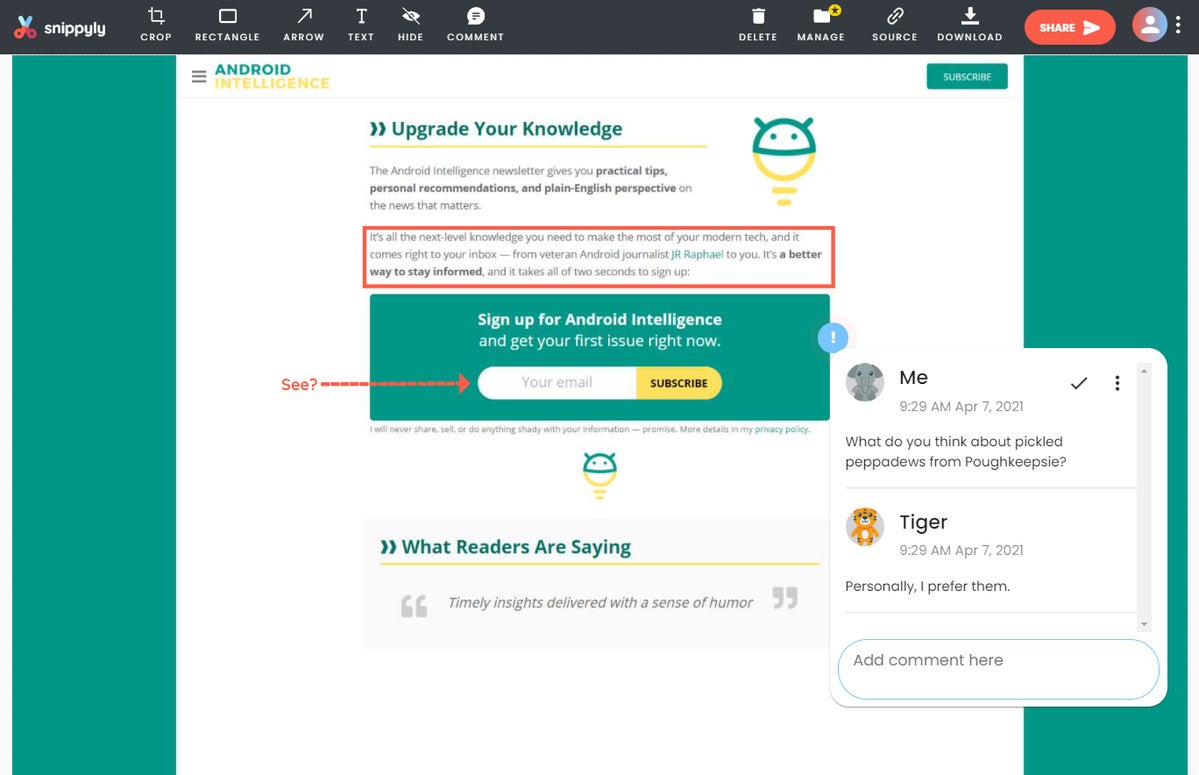 JR
JR Snippyly is one of many app-like extensions that'll add together extra value into your Chrome OS setup. (Click prototype to overstate it.)
The Chrome Web Shop likewise has an entire section of offline-capable extensions that are worth looking over.
Recollect, too, that services such as Gmail, Google Docs, and Google Bulldoze offer their ain built-in offline options (though practice be enlightened that you lot'll need to enable the offline pick in each of those services earlier it'll work; yous tin can find much more on that subject in my separate Chromebook offline guide). Chromebooks likewise come up with a scattering of preinstalled offline-capable apps, including a calculator, a patently text editor, an prototype editor, and a file manager. All of those should be in your device's launcher and ready to roll correct out of the gate.
Android apps
Another category of software that works offline and adds interesting possibilities into the Chrome Bone surround is Google's sprawling drove of Android apps — nevertheless stuff you'd install on your Android telephone, from the very same Google Play Store storefront. Most current Chromebooks support the Play Store and offering it as an choice within the Chrome OS launcher; if you lot don't meet it on your device, try opening up your Chromebook's settings and searching for "Play Store" in the box at the acme. If an choice labeled "Google Play Store" comes up, click it and follow the steps to enable its presence. If no such pick appears, your device is probably amidst the crop of older and lower-powered legacy Chromebooks that don't back up the characteristic.
The pull a fast one on with Android apps on Chrome OS is to know which apps are worth getting — which, in other words, volition actually enhance your Chromebook experience in some meaningful mode. Peculiarly since and then many Android apps are as well available in spider web-based forms, figuring that out isn't ever like shooting fish in a barrel.
I maintain an evolving list of Android apps for Chromebooks that aims to identify the well-nigh worthwhile titles. Among the apps I'd recommend installing from the Play Store are either OneNote or Keep (depending on your note-taking preference), Duet Display (which lets y'all have your Chromebook double as a wireless second display for your Mac or PC, if you utilize multiple devices), and the Google Calendar Android app (which will let you lot access your calendar offline — something its web-based brother won't do).
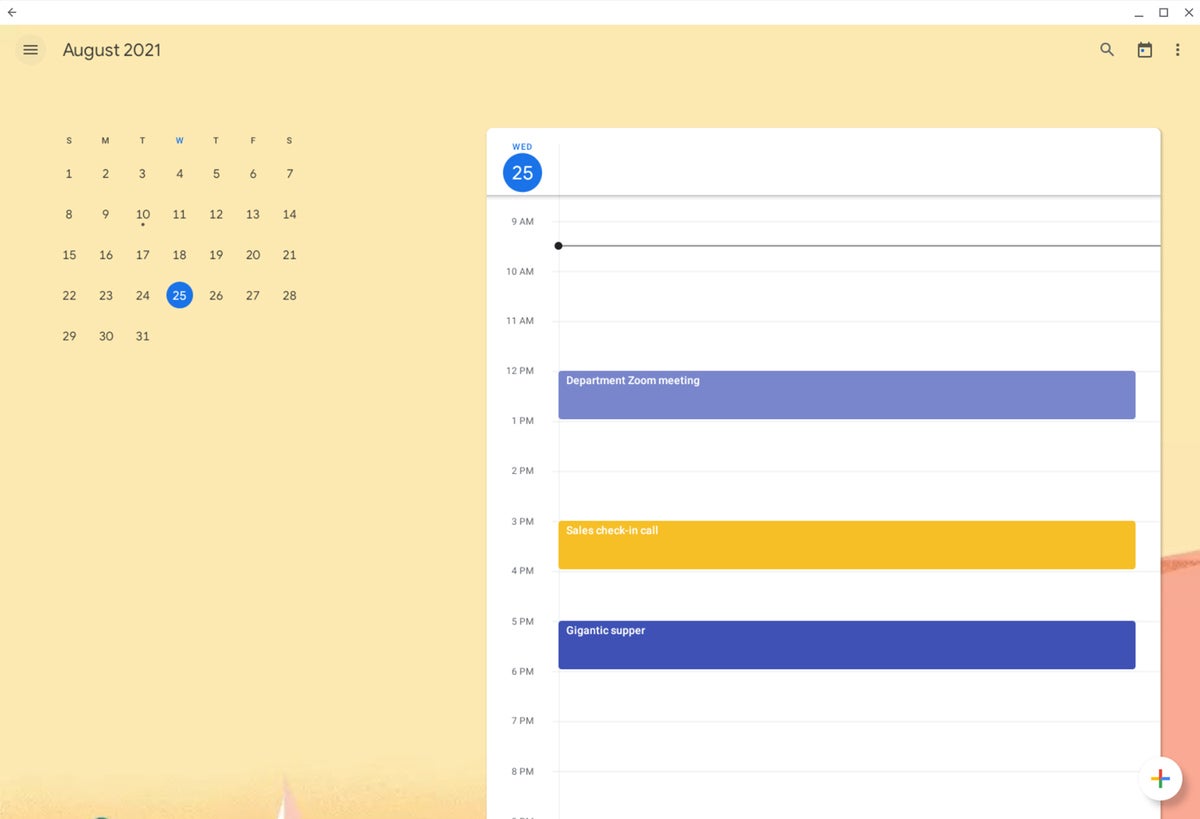 JR Raphael/IDG
JR Raphael/IDG The Google Calendar Android app has congenital-in offline access along with a more touch on-friendly interface. (Click image to enlarge it.)
There are plenty more noteworthy options in the list, and information technology's updated regularly with new recommendations.
Linux apps
The side by side blazon of app to consider one of the more contempo additions to Chrome OS and ane that certain older systems still can't support: the geek-adored domain of Linux apps. Provided y'all have a reasonably recent Chromebook and don't mind getting your hands a little muddy with technical trickery, it's well worth your while to explore.
To get-go, click over to my Linux apps on Chrome Bone guide to acquire how to get Linux upward and running on your system. So, look through my evolving listing of Linux app for Chromebook recommendations to see which titles might be right for y'all.
From a true native desktop Slack app to a fully featured local function suite and an Outlook-reminiscent email and calendar client, oodles of valuable options await.
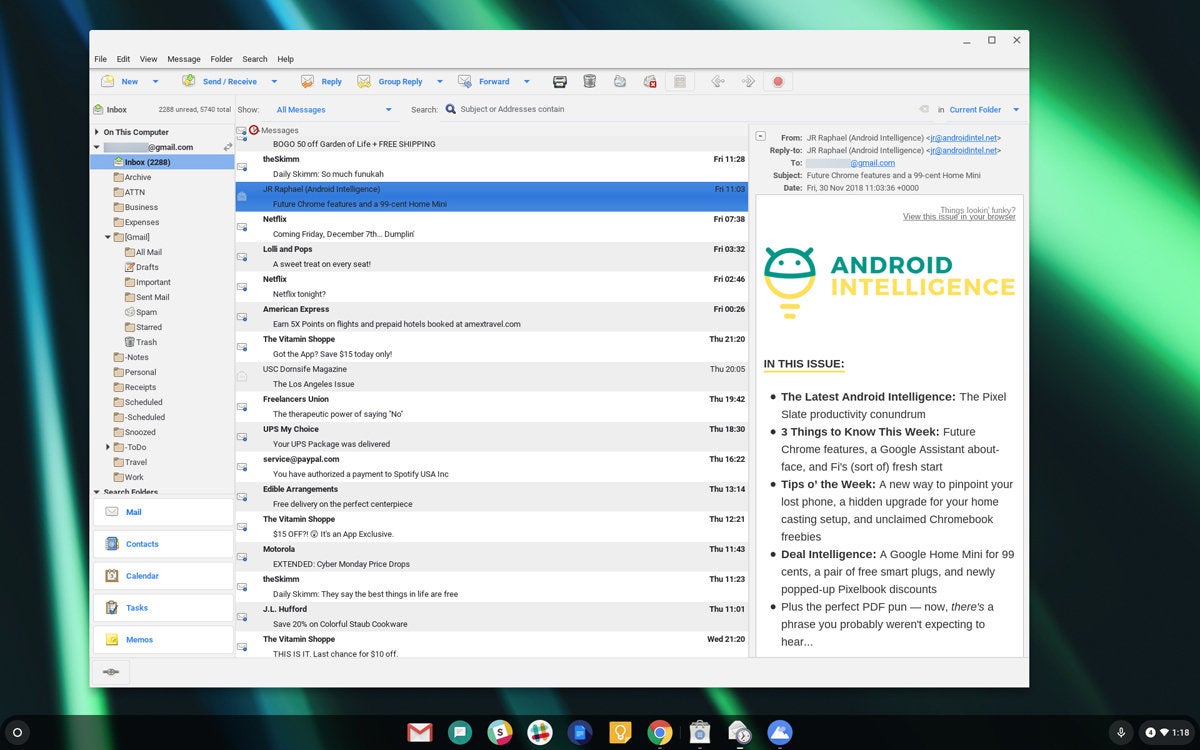 JR Raphael/IDG
JR Raphael/IDG The Linux-based Development plan gives you an Outlook-similar interface for local mail, agenda, and contact management in Chrome Bone. (Click image to enlarge it.)
Windows apps
Finally, if you piece of work in a place that yet relies on some traditional PC software, you might accept the option to access a virtual Windows desktop and use apps from that environment right on your Chromebook (yes, really!).
Google started offering an option for companies to exercise that in 2020, and Microsoft is expected to follow arrange with its ain Windows 365 Cloud PC programme in August.
This category of apps is relevant only if your employer has an enterprise-level license to utilise it, merely if you are in that situation, it could be an important function of your Chromebook productivity picture show. You lot can see more about how it works and what information technology's like to use in my hands-on assessment.
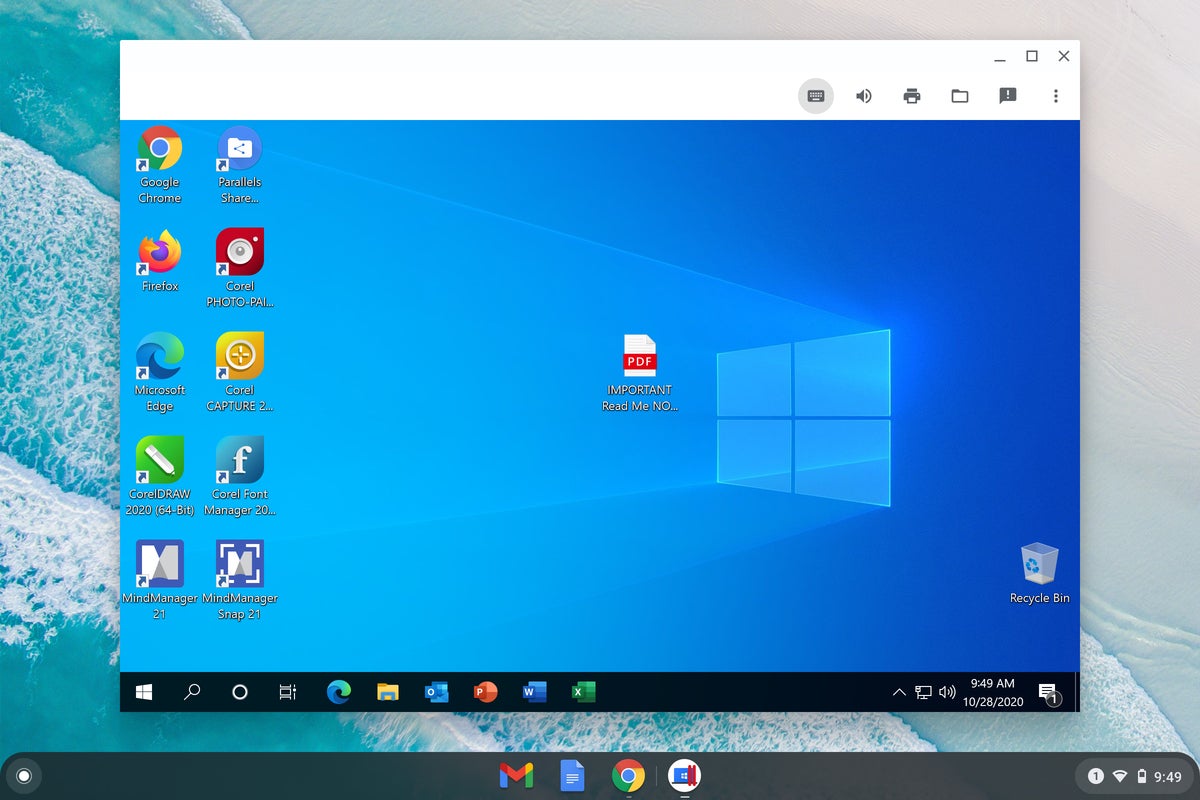 JR
JR Windows and Chrome OS tin come together in some pretty trippy means these days. (Click image to enlarge it.)
Step ii: Organize your apps for piece of cake access
With your apps all set, our adjacent footstep is to get everything organized and then you tin access what you demand with a minimal amount of ongoing effort. Chrome OS may not accept a desktop in the traditional sense, but it does have 2 important areas for app storage, as nosotros discussed at the start of this story: the launcher, or app drawer, and the shelf — the tray of docked icons at the bottom of the screen.
The launcher is where everything installed on your system appears. Yous can open it by either borer your Chromebook'due south Everything central (the ane where Caps Lock commonly goes, likewise sometimes known equally the Search fundamental or Launcher key) or by clicking the circle-shaped icon in the lower-left corner of the screen and and then clicking the up-facing arrow in the partial drawer that appears. If your device is a two-in-i that converts into a tablet — past swiveling the screen around past the 180-degree mark or by detaching the screen from the keyboard completely — the launcher will remain open on your desktop by default whenever it's in a tablet country.
Yous can elevate and drop icons throughout the launcher to change their society or drag icons atop other icons to form folders and organize things in any style yous like. Truthfully, though, you probably won't need to browse through that area too often; information technology's far faster to merely tap the Everything key or click the circle-shaped icon in the lower-left corner of the screen and so start typing the name of the app you desire. After 1 or maybe two letters, it should appear as the top pick — and you can merely hit enter to open it.
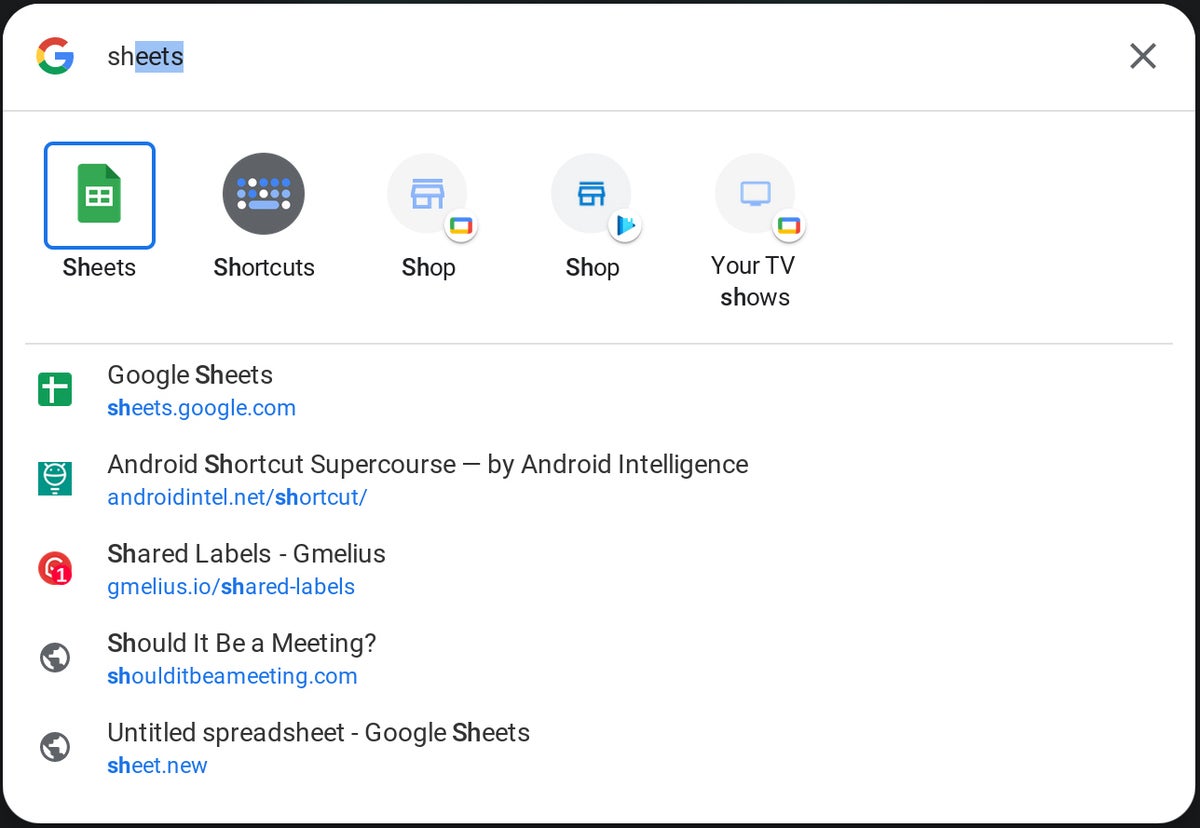 JR Raphael/IDG
JR Raphael/IDG Using the Chrome Os launcher's search role is a fast way to open any app, anytime. (Click image to enlarge information technology.)
For apps you lot open up often, find them in the launcher, right-click (or ii-finger tap) them, and then select "Pin to shelf." In one case the icon appears in your shelf, yous can drag and drop it to modify its position. Pay careful attending to that, as each position holds a hidden shortcut: From anywhere in the system, you lot can press Alt and the number central respective with an icon'southward placement in your shelf to open the associated program (or shift your focus to information technology, if it's already open).
Between the Alt-number key shortcut, the Alt-Tab app-switching command, and the Overview fundamental (the central showing a box with ii lines, directly to the left of the brightness controls on your keyboard), opening and moving among apps on Chrome Bone tin always be swift and snappy.
Pace 3: Learn some advanced shortcuts and power-user tricks
Congratulations! Your Chromebook is officially stocked, organized, and fix to help you get stuff done. All that's left to do now is think virtually learning some advanced tricks for getting around Chrome Bone and taking reward of everything it has to offer.
First of all, Chrome OS is filled with useful shortcuts beyond the few mentioned in a higher place. You can capture a screenshot by belongings downwards Ctrl and and so pressing the Overview key, for instance — or if you want to capture a specific area of the screen instead of the unabridged display, hit Ctrl, Shift, and the Overview key together then use the on-screen guides to select any area you want.
Some other especially handy shortcuts worth remembering:
Got all that? Skilful. Now, some Chromebook betterment projects worth pursuing — or hanging onto for a quiet day:
- Creating your own custom Chrome address bar actions. With a few minutes of elementary setup, you can give yourself super-fast shortcuts to practically anything imaginable — be it an element of your system, a specific website you frequent, or even a specific control inside a website (like launching a new bare email draft).
- Bringing widgets into Chrome Os. For all of its Android-inspired elements, i thing Chrome OS doesn't support yet is the time-saving home screen widget. But there's a workaround.
- Cranking up your Chromebook's cloud-connecting power. A few simple tweaks that'll make your Chromebook an even more connected part of your deject-centric setup.
- Learning fast fixes for common Chrome OS problems. A list of common Chromebook bug you might encounter and the expert-approved solutions to solve 'em.
Last but not least, if you want to get Google-axial tips and insight all throughout the yr, accept 20 seconds now to sign up for my Android Intelligence newsletter. It'll bring all sorts of next-level knowledge to your inbox every Fri — simply one email per week, from me to you lot.
This article was originally published in March 2019 and updated in August 2021.
Copyright © 2021 IDG Communications, Inc.
Source: https://www.computerworld.com/article/3341998/chromebook-cheat-sheet-how-to-get-started.html
Posted by: lanieragook1996.blogspot.com


0 Response to "How To Upload Resume From Chromebook"
Post a Comment